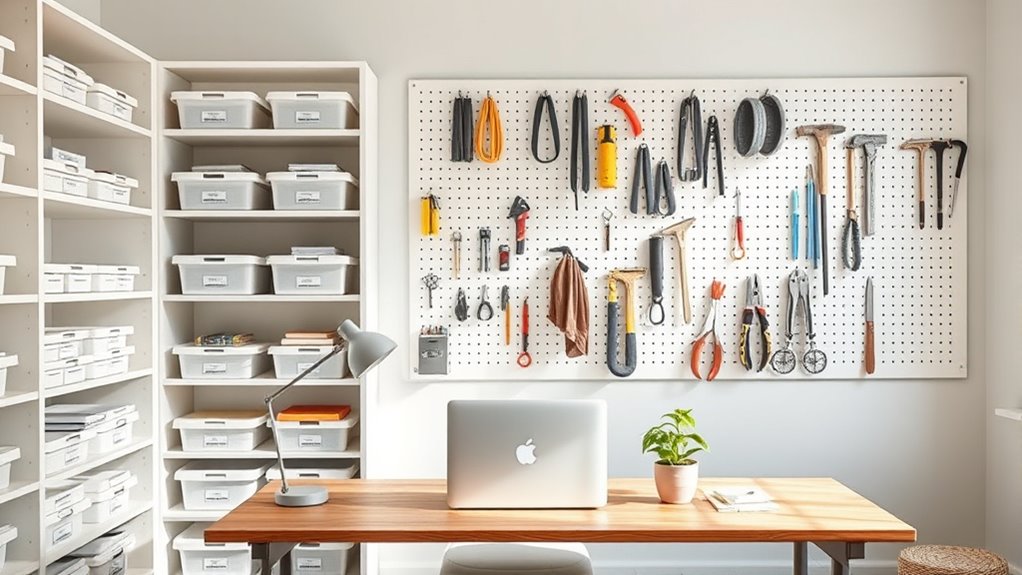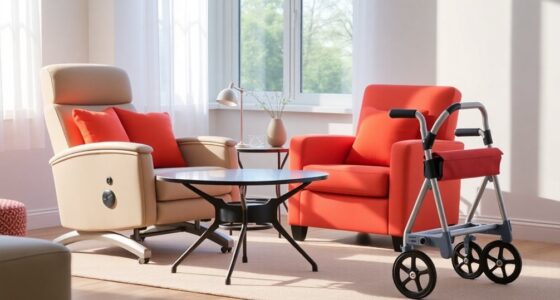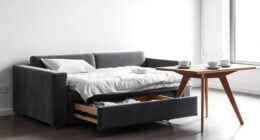To organize your space for easy access, start by measuring and clearing everything to see what you have. Group similar items, label storage areas, and use clear containers or stacking solutions to maximize space. Keep frequently used items within arm’s reach and develop habits like returning things to their designated spots. Add visual cues like signs or color codes to reinforce your system. Staying consistent with these steps helps maintain organization and simplifies everyday tasks—you’ll discover more tips as you go along.
Key Takeaways
- Categorize and group similar items, then label storage areas for quick identification.
- Use transparent containers and clear labels to easily see contents at a glance.
- Maximize vertical space with tall shelves and stackable storage solutions.
- Incorporate visual cues like signage and color-coding to reinforce organization.
- Establish daily routines, such as returning items to designated spots immediately.
Assessing Your Space and Setting Goals

To effectively organize your space, start by measuring the area accurately to understand its dimensions and pinpoint potential storage spots. This helps you assess how much storage you need and where to place it. Proper measurement ensures that your storage solutions fit well and optimize the available space.
Begin by accurately measuring your space to identify ideal storage locations and plan effectively.
Next, take everything out of the space to see what items are present, allowing a thorough assessment of what needs to be organized or discarded. As you remove items, categorize them into groups, which makes planning specific storage solutions easier. Categorization is especially helpful for items like Halloween costumes, decorations, or craft supplies, making retrieval more efficient. Incorporating vertical storage solutions can further maximize your space by utilizing wall space effectively.
Setting clear, achievable goals is vital—whether it’s reducing clutter by 50% or creating designated zones for different items. Focus on areas that impact your daily routine most, like entryways or counters, to maximize both accessibility and functionality. Establishing these goals can motivate you to stay on track and measure your progress.
Furthermore, utilizing storage containers and labeling systems can greatly enhance your organization by keeping items tidy and easy to find. Clear assessment and goal-setting are your first steps toward a more organized space. Regularly revisiting your organization plan helps maintain the improvements and adapt to changing needs.
Clearing and Decluttering Effectively
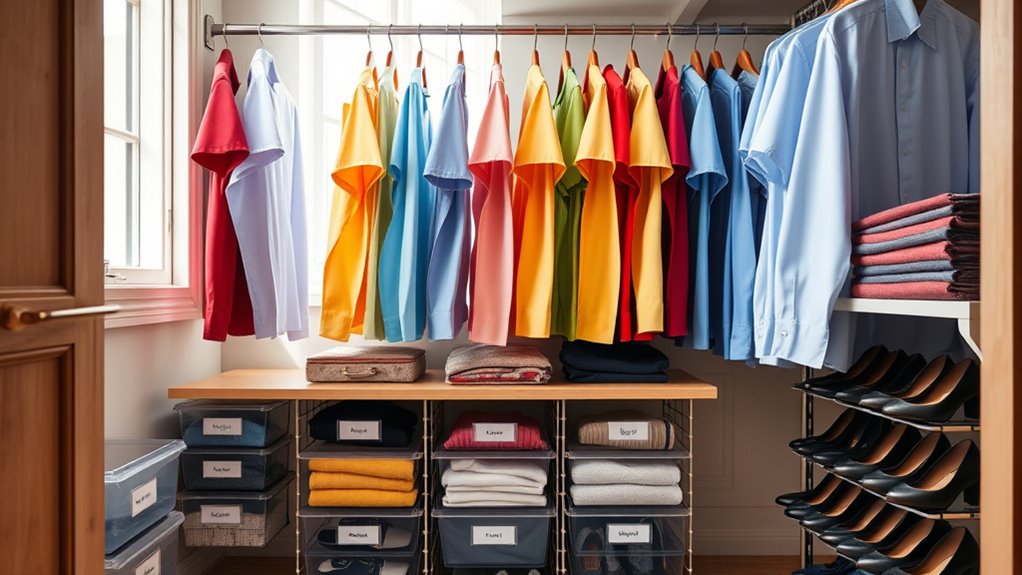
Once you’ve assessed your space and set your goals, the next step is to clear and declutter thoroughly. Start by removing everything from the area to get a clear view of what you have. Decluttering ruthlessly helps you discard broken, unused, or seldom-used items, freeing up valuable storage solutions and reducing visual clutter. Be honest with yourself—if you haven’t used something in a while, consider letting it go. Regular decluttering keeps clutter from building up again. Incorporating storage solutions designed specifically for your space can further enhance organization and accessibility. Additionally, implementing effective organization techniques can help maintain a tidy environment over time. Setting aside dedicated decluttering time regularly can prevent accumulation and maintain your organized space. This approach creates a clean, functional space ready for your next steps.
Categorizing and Grouping Similar Items
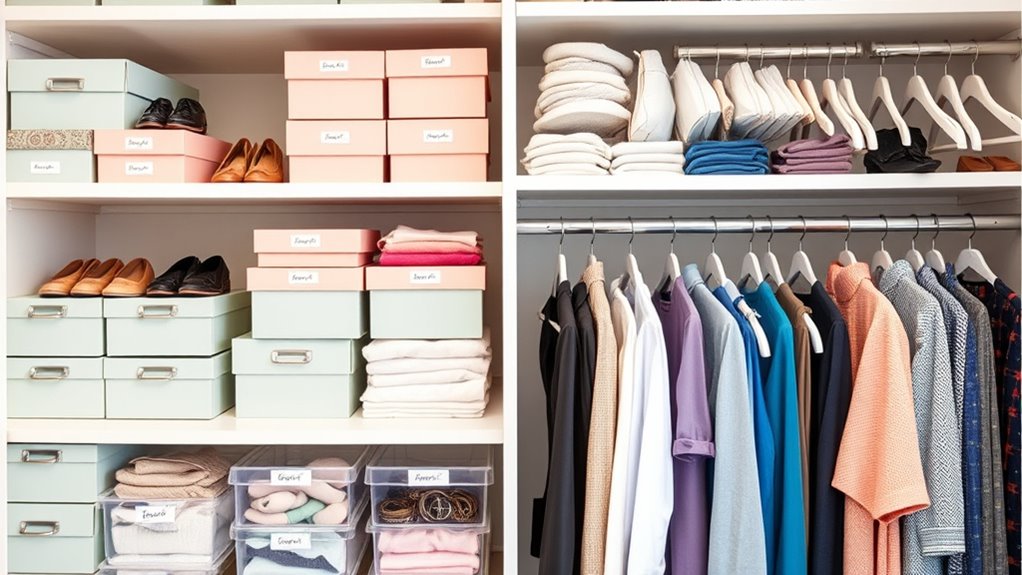
Organizing your space becomes much simpler when you start by categorizing and grouping similar items. Grouping items by categories, like all cleaning supplies in one bin, makes retrieval quick and reduces clutter. Establishing a consistent labeling system helps identify groups at a glance, which improves efficiency and keeps everything organized. Use consistent labeling and color-coding to identify groups at a glance, which improves efficiency and keeps everything organized. Store frequently used items in designated zones to minimize search time and support your daily routines. Creating designated zones for different activities can further streamline your workflow and make the space more intuitive to navigate. Incorporating visual cues, such as labels or color themes, can also enhance the ease of locating items quickly. Using appropriate storage solutions like clear containers and adjustable shelves maximizes space and maintains order. Regularly reassess and reorganize your groups to adapt to changing needs, ensuring items don’t get misplaced or forgotten. Implementing effective organization strategies can also help you maintain a clutter-free environment over time. This systematic approach keeps your space tidy, accessible, and easy to maintain over time.
Implementing Practical Storage Solutions

Implementing practical storage solutions can substantially improve your organization by making items easier to see and access. Use clear storage containers to keep similar items grouped and visible at a glance. Incorporate modular organizers to customize compartments for different purposes, ensuring everything has a designated spot. Water parks often feature themed areas and attractions that benefit from well-organized storage to enhance the visitor experience. Maximize vertical space by installing tall shelves or wall-mounted units, which keep frequently used items within easy reach and free up surface areas. Multi-purpose furniture with built-in storage offers additional hidden space, reducing clutter. Additionally, considering electric bikes and their components can inspire innovative storage ideas for smaller items and accessories. When selecting storage options, think about the tire pressure and how organized gear can contribute to maintaining optimal performance and safety. Regularly re-evaluate your setup to eliminate unnecessary items and tweak configurations for better efficiency. Being aware of regional legal resources can also help you find specialized storage or organizational solutions tailored to your space and needs. By combining these strategies, you’ll create a streamlined system that’s simple to maintain and adapt as your needs evolve.
Labeling for Clarity and Ease
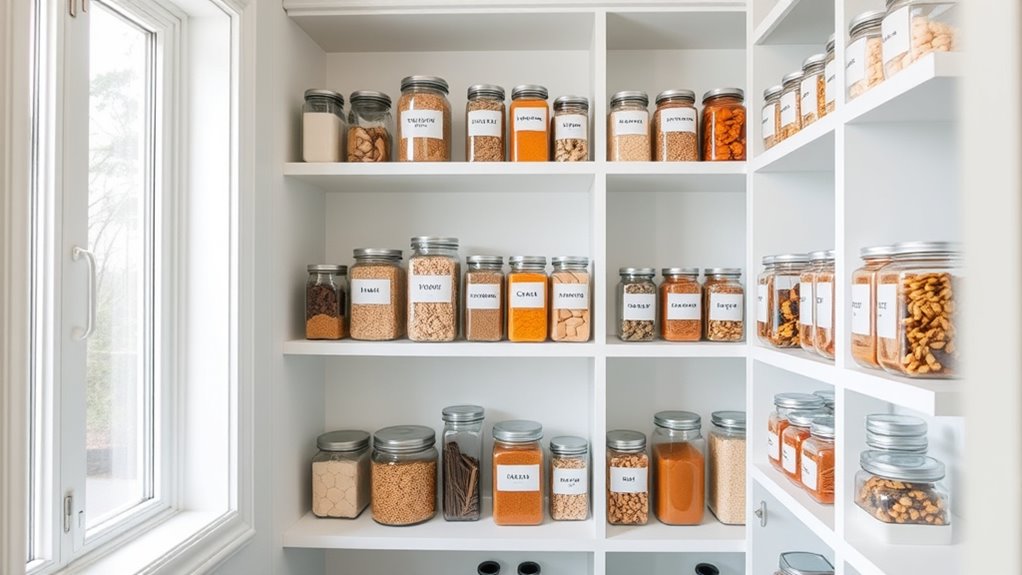
Effective labeling transforms your storage system by making it simple to identify and access items quickly. Use clear, legible tags on storage bins to reduce search time and frustration. Incorporating personalized work environments can also enhance your organization by tailoring your space to your specific needs, making it easier to keep organized. Consistent labeling styles, whether printed or handwritten, create a cohesive, organized look. For larger bins or shelves, add content lists to provide an overview of what’s stored, boosting efficiency during restocking or retrieval. Color-coded labels can visually differentiate categories, allowing you to locate specific items at a glance. Regularly update and maintain your labels to keep them accurate as your storage needs change. Proper filtration and pump protection ensures your spray equipment operates smoothly and lasts longer, reducing downtime and maintenance costs. Implementing proper labeling can also help in preventing clutter, which is essential for maintaining a functional and stress-free space. Consistent labeling can also improve your overall inventory management by helping you track items more effectively. This practice ensures your system remains clear and effective over time, saving you effort and making your space easier to navigate. Additionally, clear labels can assist in managing water safety by preventing accidental misuse or confusion around pool or water park equipment. Proper labeling is key to maintaining clarity and ease in your organization.
Arranging Items for Maximum Accessibility

To make your space truly functional, focus on placing your most-used items within easy reach, like at eye level or in accessible spots. Using clear, see-through containers helps you identify what’s inside instantly, saving time and effort. Organizing items by size and function guarantees heavier or bulkier things stay lower, making your space safer and more efficient. Incorporating mental wellbeing strategies into your organization routine can also promote a more relaxed and focused environment. Additionally, understanding store hours for your local shops can help plan your organizing sessions more effectively, ensuring you visit when stores are open and ready to assist. Recognizing conflict resolution skills can further improve your organizational process by reducing stress and fostering a calm atmosphere during decluttering. Being aware of cultural beliefs surrounding organization can also motivate you to maintain a tidy space that reflects your personal values.
Prioritize Frequently Used Items
Prioritizing frequently used items begins with placing them where you can access them easily, such as at eye level or within arm’s reach. This guarantees easy access and streamlines your daily routine. Keep everyday essentials near the entrance or in designated drop zones for quick retrieval when leaving or arriving home. Group similar commonly used items, like daily toiletries or cooking utensils, to improve organization and reduce search time. Using labels and visual cues helps you quickly identify high-traffic items, saving effort and frustration. Regularly reassess and reorganize your space to adapt to changing routines and needs. Additionally, inspecting stored items periodically helps prevent spoilage and ensures everything remains safe and functional. Proper storage in appropriate containers can further extend the shelf life of food and prevent contamination.
Utilize Clear, Visible Containers
Using clear, visible containers is one of the most practical ways to enhance your organization. These containers allow you to see contents instantly, saving time when searching for items.
Labeling see-through bins keeps everything organized and ensures items are returned to their proper spots. Grouping similar items in visible containers streamlines access and simplifies restocking routines.
Stackable clear storage solutions maximize your vertical storage space while keeping everything accessible and easy to identify. Consistently placing items in transparent containers helps maintain long-term organization by making clutter immediately visible and manageable.
With these methods, your storage space becomes more efficient, reducing chaos and increasing productivity. Clear containers are a simple yet effective way to keep your space organized and ensure everything remains easy to find.
Developing Consistent Habits and Routines
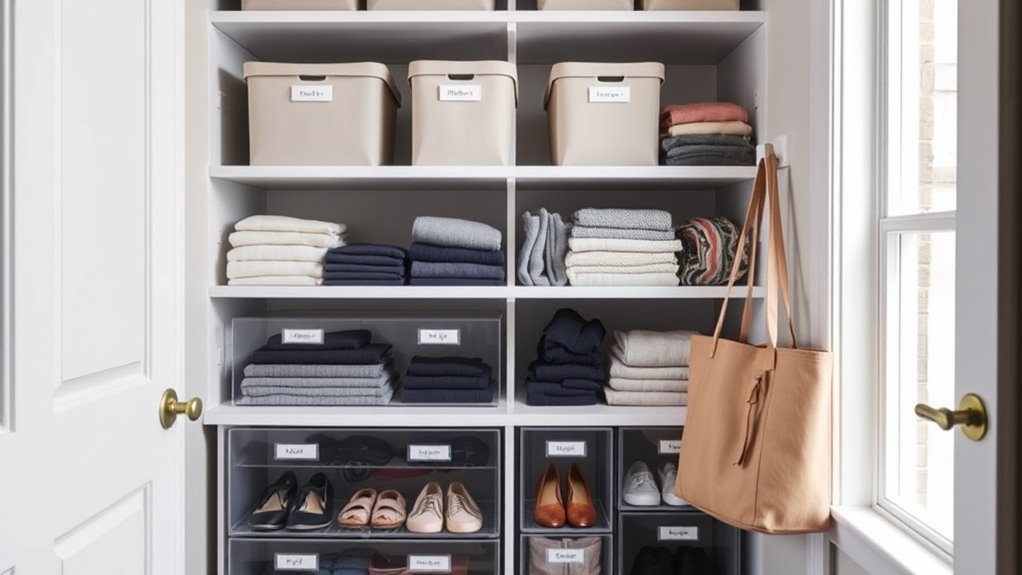
Creating daily routines like tidying up helps keep your space organized and prevents clutter from piling up.
Using visual reminders such as labels or signs consistently reinforces these habits, making them easier to stick with.
Establish Daily Routines
Establishing daily routines is key to maintaining an organized space, as consistent habits prevent clutter from accumulating over time. When you develop daily routines, you’re setting predictable behaviors that support easy access and long-term order.
To get started:
- Check and tidy up your space each evening to prevent messes from piling up.
- Always put items back in their designated spots immediately after use.
- Incorporate small habits, like putting away keys right away.
- Review your routines weekly to ensure they still work for your current needs.
These simple, consistent habits reinforce organization routines, making it easier to find what you need quickly. Over time, this approach helps you maintain a clutter-free environment, where everything has a place and is easy to access.
Use Visual Reminders
Building on your daily routines, incorporating visual reminders can considerably boost your consistency. These visual cues, like Post-it notes or labels, reinforce habits by prompting immediate action and reducing clutter. To maximize effectiveness, regularly update and position your visual reminders where they’ll be noticed. This consistency helps develop automatic routines, making organization feel effortless. Below is a simple organizing tip table to guide you:
| Reminder Type | Placement | Purpose |
|---|---|---|
| Post-it notes | Near door | Remember daily tasks |
| Labels | Shelves | Identify items easily |
| Visual cues | Work area | Maintain habits |
| Color coding | Storage bins | Prioritize |
| Signage | Entryway | Keep routines in mind |
Using these visual reminders as part of your routine will keep your space organized and accessible with less mental effort.
Reinforce Consistent Habits
Developing consistent habits and routines is essential for maintaining an organized space because it turns small actions into automatic behaviors. When you store everything properly and make sure routines are followed, clutter stays under control.
To reinforce good habits:
- Return items to their designated spots immediately after use.
- Set daily or weekly routines for tidying up.
- Use labels or reminders as visual cues to stay on track.
- Regularly assess and adjust your organizational systems to keep them practical.
Utilizing Visual Cues to Reinforce Organization
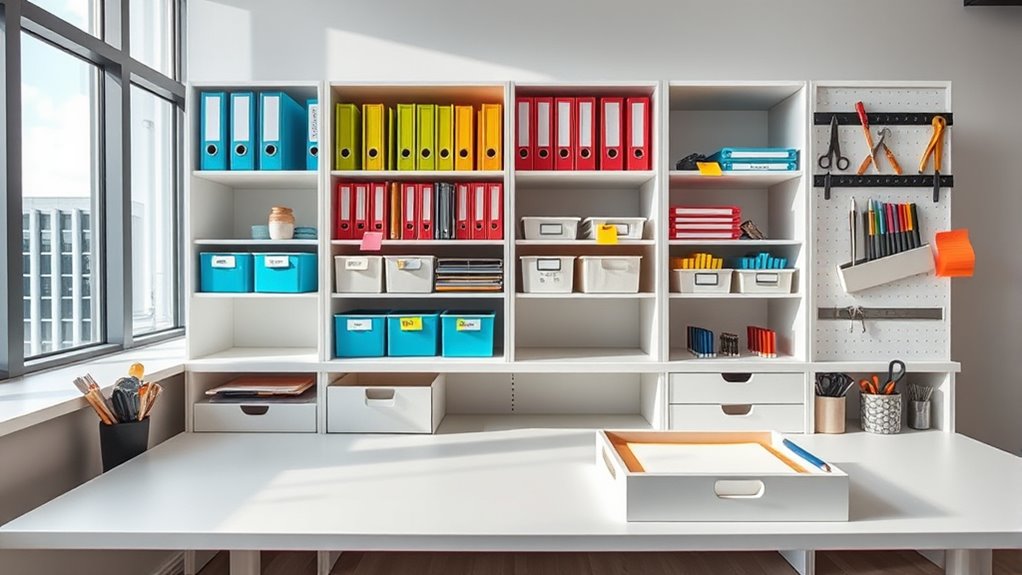
Using visual cues such as labels, signs, and color coding is one of the most effective ways to reinforce your organizational habits. They provide clear, immediate reminders of where items belong, reducing decision fatigue. Placing visual prompts like Post-it notes on key areas increases the chance you’ll return items to their proper spots consistently. Labeled containers and signage make your system intuitive, streamlining daily routines. Position visual cues at eye level or near storage zones to create automatic habits effortlessly. Incorporate the following visual cues to maximize organization:
| Visual Cues | Purpose |
|---|---|
| Labels | Clearly identify storage areas |
| Signage | Offer quick, visible reminders |
| Color Coding | Categorize items for easy recognition |
| Post-it Notes | Highlight priority or temporary zones |
| Positioning | Enhance visibility and habit formation |
Regular Maintenance and System Adjustments

To keep your organizational system effective, it’s crucial to regularly evaluate and adjust it every three to six months. Regular maintenance helps prevent clutter and guarantees your setup continues to serve your needs.
Here are four key steps:
- Review your system for inefficiencies and make small, incremental system adjustments.
- Reassess item placement, ensuring frequently used items are easily accessible.
- Update labels and visual cues to reinforce your organization habits.
- Schedule routine decluttering sessions to remove unused or unnecessary items.
Frequently Asked Questions
What Are 5 Ways to Arrange and Organize Your Space at Work?
You want to arrange and organize your space at work effectively. First, designate specific zones for tasks like meetings and storage to keep things streamlined.
Second, use labeled containers and drawers so you can find supplies quickly.
Third, add vertical storage like shelves or pegboards to maximize space.
Fourth, keep essential tools nearby to reduce movement.
Finally, declutter regularly and adjust your setup to stay efficient and tidy.
What Is the Fastest Way to Organize and Declutter?
Think of your space as a garden that needs clearing before new growth. To declutter fast, empty the entire space first, creating a blank canvas.
Remove anything unused, broken, or worn out.
Tackle small sections one at a time, seeing quick progress.
Assign specific spots for each item, and develop habits of returning items immediately.
Visual cues like labels help keep your space organized long-term, like tending to a healthy garden.
What Are the Four Organizing Styles?
You’re wondering about the four main organizing styles. Functional style keeps things accessible and efficient, using practical storage solutions for frequently used items.
Aesthetic style focuses on visual appeal, with decorative containers and color coordination.
Minimalistic style emphasizes decluttering, keeping only essentials for a clean, open look.
Traditional style relies on familiar shelves, labeled bins, and classic storage methods to maintain order and ease of access.
What Is the Space Method of Organizing?
Imagine your space is a well-organized grocery store—items are easy to find and reach. The Space Method of organizing creates zones for different items, grouping similar things together.
You prioritize accessibility by placing frequently used items at eye level and clear pathways. Decluttering first helps you see what truly belongs, then you tailor storage solutions.
Keep everything in its spot, and your space stays neat and functional effortlessly.
Conclusion
By evaluating your space, clearing clutter, categorizing items, and implementing practical solutions, you create a system that works for you. Label, arrange, and develop routines to maintain clarity and ease. Use visual cues to reinforce habits and regularly review your setup to stay organized. When you take these steps, you simplify your environment, reduce stress, and enjoy easier access—making your space not just organized, but truly functional and inviting.
